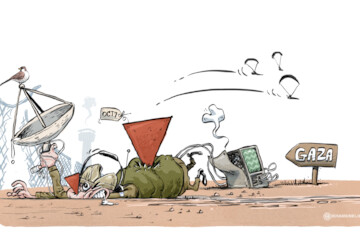Exactly one hundred days ago, in the early morning hours, the gates of the "Gaza Concentration Camp" were breached. The youth of Gaza, armed with by far less advanced weaponry than that of the Zionist regime's army, successfully penetrated the security wall encircling Gaza. This triumph, which had evaded even the combined efforts of several large Arab armies for decades, occurred on October 7, 2023. Palestinian youth fighting for Resistance, equipped with a distinctive intelligence and operational strategy, entered the occupied Palestinian territories for the first time in about 60 years. This action served as a stark reminder to the occupying regime that this land is unlawfully taken, and it won't be long before its rightful owners reclaim it.
From the early hours of the operation, the officials' responses to this operation were surprising. The Zionist regime officials were determined to obliterate Palestinian Resistance movement Hamas, forcibly evacuate Gaza residents, and eliminate Resistance in the region. The ambitious goals of the Zionists hinted at an unsuccessful genocide and a futile war crime from the outset. However, after a hundred days, it has become evident to everyone how unrealistic the objectives of the Zionists were, driven by emotions following the irreversible defeat on October 7. In what follows, we will delve into examining some aspects of these failures.
Setbacks in strategy and military operations:
The initial strategic setback occurred when all four of David Ben-Gurion's defense doctrines collapsed. These principles included deterrence, early warning, military decision, and transferring the battle to enemy territory.
The execution of operations on this scale highlighted the failure of the regime's intelligence dominance principle, the principles of deterrence and shifting combat onto the enemy's soil. The entry of Hamas forces into cities and towns around Gaza, coupled with the launch of thousands of missiles in the early stages of the battle, revealed the regime's incapacity to protect the Israeli settlers.
Another significant failure was in the realm of security services. Despite the regime's advanced spy equipment and surveillance capabilities, they were incapable of monitoring the primary communication channels among Palestinian fighters. Additionally, an excessive reliance on advanced equipment for monitoring and defending the Gaza Strip border resulted in their complete failure in the initial moments of the operation. This allowed Palestinian fighters to seize several military bases, as well as to kill and capture the soldiers within those bases. The centralization of command in the Gaza border defense line led to the failure of transmitting a warning from that base to rear lines after its destruction. Furthermore, during the months leading up to the Al-Aqsa Flood Operation, the regime's intelligence apparatus, in overconfidence, dismissed any possibility of armed operations from within Gaza. They fell into a trap as Resistance leaders, aware of their eavesdropping, intentionally disseminated misinformation to deceive the regime. Another security failure was the inability to monitor the Al-Aqsa Flood Operation, despite extensive collaborations with American security organizations.
Since the commencement of the Zionist regime's siege of Gaza and Hezbollah's attacks on the northern borders, Israeli authorities have diligently sought to downplay their reported casualties. Analyzing the concrete evidence and the historical records of the Zionist regime indicate that its media outlets cannot be deemed a reliable source for such statistics.
Over the past hundred days, the Resistance Front has dealt significant blows to the Zionist regime. In the attack on October 7, more than 300 Zionist soldiers died. By December 25, 2023, around two months after the ground assault on Gaza, over 750 armored vehicles, including tanks, personnel carriers, and engineering equipment, have sustained partial or severe damage. According to Yahya Sinwar's statement, the Zionist regime's army has seen over 5000 soldiers targeted, resulting in approximately 1600 fatalities, and the remaining forces compelled to exit the battlefield with serious injuries. Considering the scope of military conflict between the Israeli occupying forces and Hamas forces, figures and numbers referred to in Sinwar's statement seem more realistic. The northern front has been challenging for the Zionists, with more than 2000 soldiers killed or injured from October 8, 2023, to January 5, 2024. Over 40 armored vehicles, including at least 20 Merkava tanks, have been destroyed, and more than 180 Zionist military positions in that region have been under attack.
The Zionist regime faced another failure by accepting Hamas and the Resistance's terms during the prisoner and the exchange of Palestinian hostages. In this process, the Resistance released captives in central Gaza, an area the regime claimed to control, marking yet another defeat for the Zionist regime. Additionally, the Zionist regime's attempts at freeing captives through multiple stages were unsuccessful, resulting in significant casualties among its special forces and compelling them to retreat.
All these failures in Gaza underscore the complete inability of the Zionist regime to fulfill its assertion of eradicating Hamas, as its officials affirmed in the early days.
Failures in the cognitive-media warfare
Major media companies, employing discriminatory policies, have sought to downplay the extensive history of violence and expanding occupation of Gaza by the Zionists. They presented a biased and one-sided coverage of the Gaza war, aiming to shape the narrative according to hegemonic interests, influence public opinion, and strategically impact the audience. However, Western media's use of techniques and psychological operations in the Gaza issue did not achieve the intended objectives, as media audiences reacted contrary to the goals of advertising agencies in both perceiving and showing reactions to the issues.
In the early days of the war, the Zionist narrative, characterizing the Al-Aqsa Flood Operation as a terrorist and brutal act, gained traction on the internet. Yet, activists in the social media quickly began analyzing the behaviors of the Zionist regime, undermining its narrative. Within a few weeks, this one-sided narrative began to shift. The failure of the narrative depicting Hamas as having beheaded children and negatively portraying their behavior toward captured residents resulted in widespread distrust in the regime's propaganda machine. Despite the Zionist regime's attempts to silence and restrict pro-Palestine movements globally, demonstrations in the capitals of Western countries, including London, Paris, Stockholm, Washington, and others, and the support of students from renowned American universities for the Palestinian cause countered these efforts. Furthermore, many media professionals, by examining over seventy years of occupation history and demonstrating the aggressiveness and usurping nature of the Zionist regime, exposed its colonial narrative and inherent colonialism, limiting its ability to present a victim narrative.
International failures:
Political failure on the global stage
The Al-Aqsa Flood also impacted the Zionist regime's international political plans. The Abraham Accords was crucial for the regime's regional integration and dominance. The Al-Aqsa Flood effectively put a stop to the normalization and regional integration of Israel.
Israel is now without the previous level of international support, experiencing a notable decline in popularity among countries around the world. A clear sign of this waning popularity is the opposition of over two-thirds of countries worldwide to the regime and the United States in the United Nations resolutions.
Losing the international public opinion:
The atrocities committed by the Zionist regime in Gaza have led to a widespread wave of condemnation, altering international public opinion significantly. This shift has resulted in increased support for Palestine and strong condemnation of the Zionist regime. Approximately 70% of the population in the United Kingdom and around 60% in the United States are now in opposition to the aggressive policies of the Zionist regime. These two countries were traditionally considered among the primary supporters of the Zionist regime.
Failure in domestic Politics
Even before the war, a noticeable internal political divide existed within the Israeli regime, and expectations of resolving it through a war turned out to be unfounded. The Zionist regime also has failed in extinguishing the aspirations of the armed Palestinian Resistance in the occupied territories. Surveys indicate that, after October 7, over 70% of Palestinians in Gaza and the West Bank lean towards supporting armed resistance. The concept of a two-state solution has significantly waned in its appeal among the Palestinian population.
Individuals who do not belong to the Palestinian lands resorted to reverse migration as tensions heightened in Gaza and the northern borders, seeking refuge in various parts of the world. The policy of increasing the population of settlers faced setbacks, with over 230,000 settlers leaving areas near the northern borders following Hezbollah's attacks in Lebanon, and an additional 120,000 settlers escaping from the vicinity of Gaza to locations outside the occupied territories.
Economic failures
The conflict in Gaza and its aftermath put considerable strain on the import-dependent economy and the agricultural sector in the Zionist regime. Deploying approximately 220,000 military reserve forces delivered a significant blow to the regime's workforce. Some analysts project that, over the long term, this war will impose a four-hundred-billion-dollar setback on Israel's economy. With a daily cost reaching around 260 million dollars so far, this war will pose numerous economic challenges for the Zionist regime in the future. The agricultural sector in areas adjacent to the conflict zones, along the borders with Lebanon and Gaza, has been severely impacted due to a shortage of labor.
Israel's economy is highly dependent on sea imports. Disruptions in maritime trade, especially after Yemen gaining control of Bab el-Mandeb, have compelled Israel to seek assistance from the United States and its Western allies to secure its maritime trade. Several major global shipping companies have halted their partnerships with Israeli ports. Additionally, commercial ports have faced challenges due to Yemen's attacks on Eilat and Iraqi Resistance’s attacks on Haifa. These combined factors have triggered an economic downturn and raised the costs associated with imports and investments in the Zionist regime.
100-day patience and steadfastness, the cause of a 100-day Zionist defeat
The Leader of Islamic Revolution, Imam Khamenei, addressing the people of Qom on January 9, 2024, highlighted the clear signs of the regime's failure and stated:
Resistance forced the Zionist regime to retreat. The Zionist regime has failed to reach its goals after nearly 100 days. What is the meaning of defeat? That is defeat. They said they would destroy Hamas. They couldn’t. They said they would displace the people of Gaza. They couldn’t. They said we will stand in the way of the Resistance’s actions. They couldn’t. The Resistance is alive, energetic, and well-prepared, while the Zionist regime is tired, abased, filled with regret, and has been marked as a criminal. This is the situation that exists today.
Earlier, Imam Khamenei had commended the people of Gaza for their remarkable patience, steadfastness, and resilience in the face of the Zionist regime's atrocities. He foresaw victory at the beginning of the war on October 25, and now, after a hundred days, this prediction is becoming a reality.









Comment